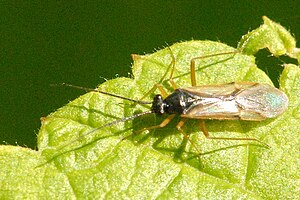Dicyphus errans
| Dicyphus errans | ||||||||||||
|---|---|---|---|---|---|---|---|---|---|---|---|---|

Dicyphus cf. errans |
||||||||||||
| Systematics | ||||||||||||
|
||||||||||||
| Scientific name | ||||||||||||
| Dicyphus errans | ||||||||||||
| ( Wolff , 1804) |
Dicyphus errans is a species of bug from the family of soft bugs (Miridae).
features
The bugs are 4.5 to 5.1 millimeters long. Species of the genus Dicyphus are usually difficult to identify based on external characteristics, but the color can still be helpful. Dicyphus errans has a black first and second antennae and the head and pronotum are predominantly black. The dark gray hemielytres and black spotted legs are characteristic of the species. The adult bugs are always fully winged (macropter). The length of the third antennae is greater than or equal to the width of the head at the level of the compound eyes and the rails ( tibia ) of the hind legs are long.
Occurrence and habitat
The species is distributed from southern Scandinavia to the Mediterranean region without North Africa and south-east to the Caucasus. It is widespread and not uncommon in Central Europe except in the North German lowlands, from which only isolated finds have been documented.
The herbaceous layer is mainly populated by mesophilic , open habitats. The species is also found in gardens and greenhouses.
Way of life
The bugs feed on zoophytophagus and, unlike the other species of their genus, live on many different host plants from different families. They are also found on cultivated plants, such as the cucurbit family (Cucurbitaceae). They are often found on sticky plants with glandular hair, especially on cranesbills ( Geranium ), ziesten ( Stachys ), heron's beaks ( Erodium ), adder heads ( Echium ), ragweeds ( Senecio ), glutinous herbs ( Silene ), sage ( Salvia ) and nettles ( Urtica) ). Together with other Dicyphus species, Dicyphus errans can also be found on their host plants such as foxgloves ( digitalis ), deadly nightshade ( Atropa bella-donna ), grouse ( Ononis ), ziesten and shaggy fireweed ( Epilobium hirsutum ). They also suckle on small invertebrates such as fringed winged birds , spider mites and aphids and on dead animals that stick to the glands of the host plants. They need predatory nutrition for their development. The adult bugs are very active in flight at higher temperatures and also fly to artificial light sources at night. The adults overwinter on the ground, for example under the rosettes of mullein and are usually active until late into winter. It is believed that only mated females overwinter. These sink their eggs into the stems or the leaf tissue of the host plants. In favorable years, two generations can be formed whose nymphs are adult in June and July; the second generation then appears in August and September.
supporting documents
Individual evidence
- ↑ a b c d Ekkehard Wachmann , Albert Melber, Jürgen Deckert: Bugs. Volume 2: Cimicomorpha: Microphysidae (lichen bugs), Miridae (soft bugs) (= The animal world of Germany and the adjacent parts of the sea according to their characteristics and their way of life . 75th part). Goecke & Evers, Keltern 2006, ISBN 3-931374-57-2 , p. 27 f .
- ↑ Dicyphus errans. British Bugs, accessed January 3, 2015 .
literature
- Ekkehard Wachmann , Albert Melber, Jürgen Deckert: Bugs. Volume 2: Cimicomorpha: Microphysidae (lichen bugs), Miridae (soft bugs) (= The animal world of Germany and the adjacent parts of the sea according to their characteristics and their way of life . 75th part). Goecke & Evers, Keltern 2006, ISBN 3-931374-57-2 .
Web links
- Dicyphus errans at Fauna Europaea. Retrieved January 3, 2015
- www.britishbugs.org.uk - photos, description